Manila Cathedral
| Manila Cathedral | |
|---|---|
|
Manila Metropolitan Cathedral-Basilica Cathedral-Basilica of the Immaculate Conception Kalakhang Katedral-Basílika ng Kalinís-linisang Paglilihî ni María Catedral-Basílica Metropolitana de la Inmaculada Concepción de María | |
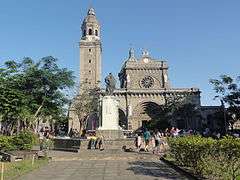 Façade of The Cathedral | |
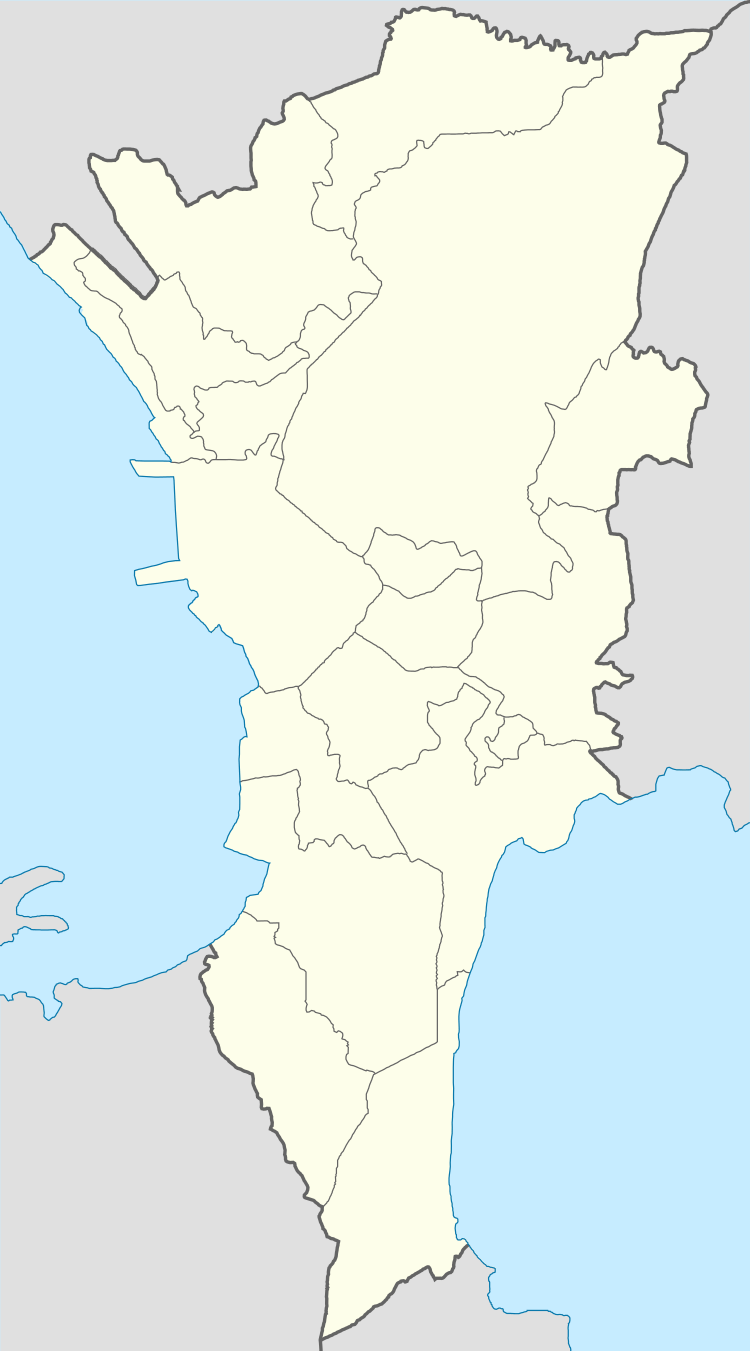 Manila Cathedral Location in Metro Manila | |
| 14°35′29″N 120°58′25″E / 14.59147°N 120.97356°ECoordinates: 14°35′29″N 120°58′25″E / 14.59147°N 120.97356°E | |
| Location | Manila |
| Country | Philippines |
| Denomination | Catholic Church |
| Website | Manila Cathedral official website |
| History | |
| Former name(s) | Church of Manila |
| Authorising papal bull |
February 6, 1579 Pope Gregory XIII |
| Founded | 1571 |
| Founder(s) | Padre Juan de Vivero |
| Dedication | Immaculate Conception of the Blessed Virgin Mary |
| Consecrated | 1581 |
| Events |
April 9, 2014 (formal reopening following restoration) January 16, 2015 (Pope Francis' Papal Mass) |
| Past bishop(s) |
List of Archbishops of Manila Rufino J. Card. Santos (1953–1974) Jaime Card. Sin (1974–2003) Gaudencio Card. Rosales (2003–2011) |
| Architecture | |
| Status | Minor Basilica |
| Functional status | Active |
| Architect(s) | Fernando H. Ocampo |
| Architectural type | Cathedral Basilica |
| Style | Neo-Romanesque |
| Groundbreaking | 1954 |
| Completed |
1958 (present structure) 2014 (earthquake retrofitting) |
| Construction cost | ₱70 million (2012–2014 restoration) |
| Closed | February 7, 2012 – March 25, 2014 |
| Demolished | 1945 (Battle of Manila) |
| Specifications | |
| Number of floors | 2 |
| Number of domes | 1 |
| Number of spires | 1 |
| Materials | Adobe and cement |
| Administration | |
| Archdiocese | Roman Catholic Archdiocese of Manila |
| Province | Ecclesiastical Province of Manila |
| Clergy | |
| Archbishop | Luis Antonio Cardinal Tagle, DD., S.Th.D. |
| Rector | Rev. Fr. Reginald R. Malicdem, MAL |
| Assistant | Rev. Fr. Kali Pietre Llamado |
The Minor Basilica and Metropolitan Cathedral of the Immaculate Conception (Filipino: Kalakhang Katedral Basílika ng Maynilà; Spanish: Catedral Basílica Metropolitana de Manila), informally known as Manila Cathedral, is a Roman Catholic basilica located in Manila, Philippines, dedicated to the Blessed Virgin Mary as Our Lady of the Immaculate Conception, the Principal Patroness of the Philippines. The cathedral serves as the see of the Archbishop of Manila.
Located at Plaza de Roma in the Intramuros district of the City of Manila, the cathedral was originally a parish church owned and governed by the Archdiocese of Mexico in 1571, until it became a separate diocese on 6 February 1579 upon the issuance of the papal bull, Illius Fulti Praesido by Pope Gregory XIII.[1] The cathedral was damaged and destroyed several times since the original structure was built in 1581 while the eighth and current instance of the cathedral was finally completed in 1958.[2]
The basilica has merited a papal endorsement from Pope Gregory XIII and three apostolic visits from Pope Paul VI, Pope John Paul II and Pope Francis. On 27 April 1981, Pope John Paul II issued papal bull Quod Ipsum designating the cathedral as a minor basilica by his own Motu Proprio.[3]
History

The cathedral was originally the "church of Manila" officially established in 1571 by a secular priest, Juan de Vivero, who arrived in Manila Bay in 1566.[5] De Vivero, the chaplain on the galleon of San Gerónimo, was sent by the Archbishop of Mexico, Alonso de Montúfar, to establish Christianity as the spiritual and religious administration in newly colonized Philippines. De Vivero later became the vicar-general and the first ecclesiastical judge of the city of Manila.
Spanish conquistador Miguel López de Legazpi chose the location of the church and placed it under the patronage of Santa Potenciana. The first parish priest of the church was Juan de Villanueva.[6]
When the church was raised to a cathedral in 1579, a new structure made from nipa, wood, and bamboo was constructed in 1581 by Domingo de Salazar, the first bishop of Manila. The new structure was consecrated on December 21, 1581, formally becoming a cathedral. The structure was destroyed by fire in 1583, which started during the funeral Mass for Governor-General Gonzalo Ronquillo de Peñalosa in San Agustin Church that razed much of the city.[1]
The second cathedral, which was made of stone, was built in 1592. It was destroyed by an earthquake in 1600. Construction of the third cathedral began in 1614. The new structure, consisting of three naves and seven chapels, was blessed in 1614. It was toppled by another earthquake which shook Manila in 1645. The fourth cathedral was constructed from 1654 to 1671. In 1750, a media naranja ("half orange") dome was added to the crossing by the Florentine friar Juan de Uguccioni, who also introduced a transept to the structure.[7]
It was severely damaged in 1863 by a very strong earthquake that also damaged the palace of the Governor General of the Philippines. In 1880, another earthquake toppled its bell tower, rendering the cathedral towerless until 1958. The seventh cathedral was constructed from 1870 to 1879. It was solemnly blessed in December 1879. The cross atop the central dome is a reference point of astronomical longitudes of the archipelago.
In 1937, the International Eucharistic Congress was held in the Philippines in which the cathedral played an integral part in promoting eucharistic beliefs. Both a cathedral stamp and medal was struck in commemoration of the event and was made by the official manufacturer of medals for the Congress of the Philippines at the time, the sculptor Críspulo Zamora.[8]
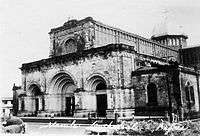
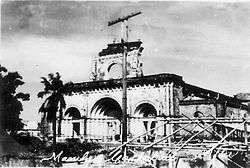
This incarnation of the cathedral was reduced to rubble by Allied bombardment in 1945 during the Battle of Manila, as the Second World War neared its conclusion.
The present cathedral was constructed from 1954 to 1958 under Cardinal Rufino Jiao Santos and under the supervision of the notable Filipino architect Fernando H. Ocampo.
Pope Paul VI made an apostolic visit and celebrated Mass in the cathedral in 1970. Pope John Paul II issued a papal bull Quod Ipsum on April 27, 1981, elevating the shrine to a minor basilica through his own Motu Proprio.[3] In the same papal bull, He reiterated that the Pope Paul VI's papal decree of June 6, 1968 be eternally preserved and enforced to the merits and titles of the cathedral as its own basilica.[9][10]
The cathedral's 50th restoration anniversary was celebrated in 2008, highlighted by the second Manila Cathedral Pipe Organ Festival from December 2 to 10, organized by the Catholic Bishops' Conference of the Philippines.[11]
In February 2011, the Archdiocese of Manila relocated the bells of the cathedral to the ground level to prevent tower collapse as exhibited in the past earthquakes. In January 2012, the cathedral replaced the bells, personally cast by blacksmith Friedrich Wilhelm Schilling of Heidelberg Germany in 1958. According to the new marker installed by Cardinal Gaudencio Rosales, the newly installed bells are the largest bells actively used in the Philippines. A total of seven Carillon bells were permanently installed in the ground level of the belfry weighing at 17 metric tons.[12]
2012 renovation and 2014 reopening
The cathedral underwent repairs for earthquake retrofitting and subsidence prevention in 2012.[13][14][15] During such period, the San Fernando de Dilao Church has been designated as the temporary official church (Pro-Cathedral) of the Archdiocese of Manila.[16] However, Msgr. Nestor Cerbo stated that the Cathedral will finish its renovations last March 25, 2014. Some added features and changes include installation of CCTV cameras, large flat screen television screens (similar to the Baclaran Church), improved audio-video systems, and improved interior and exterior LED lightings.[17] The cathedral completed its restoration on the said date and was reopened to the general public last April 9, 2014 after two years of renovation. Manila Archbishop Luis Antonio Tagle led a holy mass after the reopening of the Cathedral attended by President Benigno Aquino III.[18][19]
2015 Papal Visit
On January 16, 2015, Pope Francis celebrated his first Papal Mass at the Cathedral as part of his Papal visit in the Philippines. However, the Mass was exclusive for the bishops, priests and the clergy.
The Mass was celebrated in three languages, English, Filipino, and Latin
Patron saint

In 1581 Pope Gregory XIII issued a papal bull consecrating the cathedral building to La Purísima Inmaculada Concepción de María,[1] while Miguel López de Legazpi consecrated the city of Manila to Saint Potenciana.
On 12 September 1942, Pope Pius XII rededicated the Filipino people to La Purísima Inmaculada Concepción through a Papal Bull called Impositi Nobis, while Saint Rose of Lima and Saint Potenciana remained as the secondary patronesses of the Filipino people.
The Latin declaration came in the Acta Apostolicae Sedis from January 20, 1942.[20]
Shrine rectors
- Most Rev. Artemio Gabriel Casas, D.D. (1956-1962)
- Rev. Msgr. Jose C. Abriol, P.A. (1962-1975)
- Rev. Msgr. Augusto Pedrosa, H.P. (1975–1985)
- Rev. Msgr. Domingo A. Cirilos, Jr., P.C. (1985–1996)
- Rev. Msgr. Hernando M. Coronel, P.C. (1996–2002)
- Rev. Msgr. Nestor C. Cerbo, P.C. (2002–2015)
- Rev. Fr. Reginald R. Malicdem, (July 1, 2015 – present)
Burials and funerals
The cathedral crypt is the resting place for former Archbishops of Manila and a few other prelates:
- Michael J. O'Doherty, the last foreign Archbishop of Manila
- Gabriel M. Reyes, the first Filipino Archbishop of Manila
- Cardinal Rufino J. Santos, the first Filipino Cardinal
- Cardinal Jaime L. Sin, a prominent leader of the 1986 People Power Revolution
- Dom Ambrose Agius, a Maltese monsignor who ordained the first Filipino bishop (until 1945; remains transferred to the Abbey of Our Lady of Montserrat, Mendiola Street, Manila).
Two former Presidents were permitted to lie in state under the Cathedral dome:
- Carlos P. García, 8th President of the Philippines (1957–1961) (d. 1971);
- Corazón C. Aquino, 11th President of the Philippines (1986–1992) (d. 2009).
President García was the first layman to lie-in-state and have his Requiem Mass said at the cathedral; President Aquino was only the second layperson and the first woman given this honour during her funeral. This broke with centuries of tradition that reserved the right of lying-in-state beneath the dome to Archbishops of Manila.[21]
Details of the shrine
The main façade is a replica of the façade of the previous cathedral, along with statues of famous saints sculpted in Roman travertine stone. Several of the artworks inside the basilica were made by Italian artists. In the previous cathedral, they were originally made of molave wood. The statues of Saint Rose of Lima was sculpted by Angelo Fattinanzi while Saint Jacob, Saint Andrew, St. Anthony the Abbott was done by sculptress Livia Papini; St. Francis Xavier St. Polycarp by Alcide Tico.[22]
The tympanum above the central northwest doors bears the Latin inscription Tibi cordi tuo immaculato concredimus nos ac consecramus (English: To your Immaculate Heart we are entrusted for safekeeping and consecrated).
Since Pope John Paul II's apostolic visit to the basilica in 1981, a medallion bearing the Papal arms has been placed beneath the cross on the northwest end. The red galero hat of Cardinal Rufino Santos is also suspended from the ceiling of the dome. In addition, a copy of Saint Peter's statue (attributed to Arnolfo di Cambio) is enshrined inside, across a polychrome life-sized statue of the Immaculate Conception.
Prior to 1988, the bronze statue of the Immaculate Conception in the main altar, by renowned Italian sculptor Maestro Enzo Assenza, was painted gold until 1988 (though the twelve star halo-aureola is solid gold).[23][24] Inscribed on the baldachin above the statue of the Immaculate Conception is the Latin antiphon Tota Pulchra es Maria et Macula Originalis Non est in Te (English: "You are all beautiful, Mary, and the original stain [spot] (of sin) is not in you.").
The baptismal font and angelic holy water fonts are also made of solid bronze by Publio Morbiducci; while the prominent mosaic of Saint Jude Thaddeus was made by Marcello Mazzoli. The 134 modern stained glass windows were made in 1964 by Filipino artist, Galo Ocampo, focusing on Marian themes and was commissioned and funded by Cardinal Rufino Jiao Santos.
The artistic designs of the stained glass windows of the Manila Cathedral are mostly products of the creative genius of Galo Ocampo, one of the most versatile contemporary Filipino artists during his time and a recipient of the 1964 Patnubay ng Sining at Kalinangan Award from the city government of Manila.[25]
Gallery
-
_by_Brambila.jpg)
The cathedral in 1792, by Fernando Brambila
-
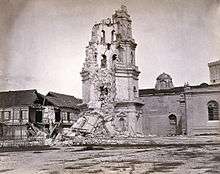
Manila Cathedral belfry after the 1880 earthquake
-

The cathedral
-

The patinated dome of the cathedral and its four-armed cross
-
Interior of the Manila Cathedral
-
The central nave and vaulted ceiling of the cathedral
-
The vaulted ceiling of the cathedral
-

A wedding at the high altar
-
The high altar
-
Iron gates inside restored
-
Marble floors and columns repolished
-
The dome of the cathedral from the inside
-
Manila Cathedral at night
-

Manila Cathedral at night, the Charles IV monument in the foreground
See also
- Manila Cathedral-Basilica Re-Opening (April 9, 2014 Eucharist after Restoration and Retrofitting)
- Roman Catholic Archdiocese of Manila
- Roman Catholicism in the Philippines
- San Agustin Church
- Intramuros
References
- 1 2 3 "The First Cathedral:1581 - 1583". Manila Metropolitan Cathedral-Basilica. Retrieved on 2011-11-24.
- ↑ "The Eight Cathedral: 1958 - Present". Manila Metropolitan Cathedral-Basilica. Retrieved on 2011-11-24.
- 1 2 (1981-04-27). "Quod Ipsum". Litterae Apostolicae. Ioannem Paulum Secundum, Papam. Manillensis Archidiocesis.
- ↑ http://www.aenet.org/manila-expo/page16.htm
- ↑ "History of the City". City of Manila Official Website. Retrieved on 2011-11-24.
- ↑ "The Church before it became a Cathedral : 1571". Manila Metropolitan Cathedral-Basilica. Retrieved on 2011-11-24.
- ↑ "Dome". Manila Metropolitan Cathedral-Basilica. 22 July 2014. Retrieved 4 February 2015.
|first1=missing|last1=in Authors list (help) - ↑ (2012-04-28)."The Resilient Cathedral of Manila". The Philippines And Then Some.
- ↑ (1968). "Acta Apostolicae Sedis - Commentarium Oficiale", pp. 536-539. The Vatican Archives. Retrieved on 2012-02-03.
- ↑ (1990). "Acta Apostolicae Sedis - Commentarium Oficiale - Ioannem Paulum Secundum, Papam. Decretum de Titulo Basilicae Minoris". pp. 436-440. The Vatican Archives. Retrieved on 2012-02-03.
- ↑ (2008-04-29). "Activities lined up for Manila Cathedral's 50th restoration anniversary". GMA News Online.
- ↑ Official Stone Marker at the Manila Cathedral. Publicly installed by Cardinal Gaudencio Rosales, former Archbishop of Manila (2011). Located on the left side of the front door of the Basilica
- ↑ "Manila Cathedral closes for a year". ABS-CBN News. Retrieved February 16, 2012.
- ↑ "Manila Cathedral to be closed for one year". Philippine Daily Inquirer. Retrieved February 16, 2012.
- ↑ "Manila Cathedral not safe, to be shut for repairs". Business World Online. Retrieved February 16, 2012.
- ↑ "Manila Cathedral still remains under repair". Retrieved December 17, 2013.
- ↑ http://www.interaksyon.com/article/79041/manila-cathedral-to-open-in-march
- ↑ http://www.abs-cbnnews.com/focus/03/24/14/facelift-over-manila-cathedral-gets-brighter -Manila Cathedral renovations completed
- ↑ Rie Takumi (April 9, 2014). "Manila Cathedral reopens after two years of reconstruction work". GMA News. Retrieved April 10, 2014.
- ↑ Pius XII, Papam (1942-09-12). "Acta Apostolicae Sedis, Impositi Nobis: Insularum Philippinarum Beatissima Virgo Maria Titulo Immaculata Conceptio Primaria Universalisque Patrona et Sanctae Virgines Pudentiana ac Rosa Limana Patronae Secundarias Declarantur.". pp. 336-337. The Vatican Archives. Retrieved on 2012-02-03.
- ↑ Quezon, Manolo (2009-08-13). "Notes on the Aquino funeral". The Philippine Daily Inquirer. INQUIRER.net. Retrieved 2009-08-15.
- ↑ "Statues". Manila Metropolitan Cathedral-Basilica. Retrieved on 2011-11-24.
- ↑ "Baldacchino Altar (1980s)". Flickr.com. Retrieved on 2012-02-03.
- ↑ "Manila Cathedral Ordination". Flickr.com. Retrieved on 2012-02-03.
- ↑ Ortiguero, Romsanne. "With more resilient foundation, Manila Cathedral is all set for Holy Week and Easter Masses". Interaksyon.com. Retrieved May 3, 2014.
External links
| Wikimedia Commons has media related to Manila Cathedral. |
